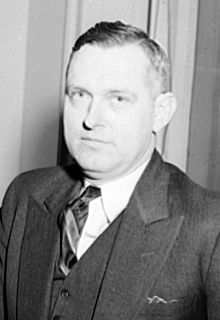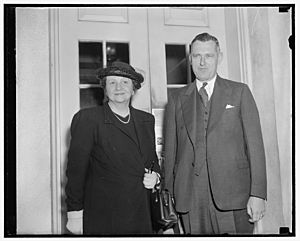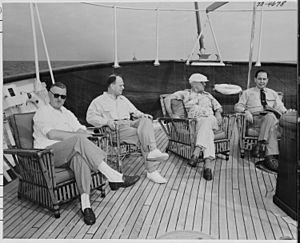John R. Steelman facts for kids
Quick facts for kids
John R. Steelman
|
|
|---|---|
 |
|
| Director of the Office of Defense Mobilization Acting |
|
| In office March 31, 1952 – September 8, 1952 |
|
| President | Harry S. Truman |
| Preceded by | Charles Wilson |
| Succeeded by | Henry H. Fowler |
| 1st White House Chief of Staff | |
| In office December 12, 1946 – January 20, 1953 |
|
| President | Harry S. Truman |
| Preceded by | Position established |
| Succeeded by | Sherman Adams |
| Personal details | |
| Born |
John Roy Steelman
June 23, 1900 Thornton, Arkansas, U.S |
| Died | July 14, 1999 (aged 99) Naples, Florida, U.S. |
| Resting place | Arlington National Cemetery |
| Education | Henderson State University (BA) Vanderbilt University (MA) University of North Carolina, Chapel Hill (PhD) |
John Roy Steelman (born June 23, 1900 – died July 14, 1999) was a very important person in the United States government. He was the first person to hold a special job called "The Assistant to the President." He worked for President Harry S. Truman from 1946 to 1953. This job later became known as the White House Chief of Staff, which is like the President's main helper and organizer. Steelman held this role for six years, which is the longest anyone has ever served as Chief of Staff!
Contents
Growing Up and Going to School
John Roy Steelman was born on a farm in Thornton, Arkansas. His parents were Martha Ann and Pleasant C. Steelman. After finishing high school, he served in World War I.
To save money for college, he worked many different jobs. He was a bookkeeper, worked in logging, and helped on farms. He even rode trains to Wichita, Kansas, to work in wheat fields. He was proud to call himself a blanket stiff, which was a term for a traveling worker who carried their blanket.
Steelman was a descendant of Olof Persson Stille. Olof was an immigrant to New Sweden and a chief justice in one of its courts. Some of his family later changed their last name from Stille to Steelman.
John Steelman went to Henderson Brown College in Arkadelphia, Arkansas, and graduated in 1922. He then went to Vanderbilt University, where he earned his Master of Arts (MA) degree in 1924. In 1928, he received his Ph.D. from the University of North Carolina. He studied economics and sociology. From 1928 to 1934, he was a professor at Alabama College in Montevallo, Alabama.
His Career in Government
After getting his Ph.D., Steelman started teaching at Harvard University. Later, he became a sociology professor at Alabama College. In 1934, Frances Perkins, who was the Secretary of Labor at the time, gave a speech at his college. She met Steelman and was very impressed by how he had helped solve a labor problem in Mobile, Alabama.
Ken Hechler, a writer, said that Perkins was impressed by "the huge, open-faced, smiling man." He taught economics but spoke in a very down-to-earth way. He seemed to know a lot about labor issues, which interested Secretary Perkins. She convinced him to join the federal government. He became part of the United States Conciliation Service. This was an agency in the Labor Department that helped solve disagreements between workers and businesses. After three years, he became the Commissioner of Conciliation.
After President Franklin D. Roosevelt was elected for his fourth term, Steelman worked for a short time in New York City. He was a public relations consultant. But when President Roosevelt died in 1945, Vice President Harry Truman became President. Steelman then returned to the federal government. He became an adviser to the Secretary of Labor.
Later, he became a special assistant to the President. He also served as the Director of the Office of War Mobilization and Reconversion. In 1946, he got the important job of "The Assistant to the President." In 1948, he was offered the job of Secretary of Labor, but he chose to stay at the White House. He especially focused on creating new rules for science and higher education.
Before working directly in the White House, Steelman held several important roles:
- Commissioner of Conciliation, U.S. Conciliation Service, Department of Labor (1934–1936)
- Special Assistant to the Secretary of Labor (1936–1937)
- Director, U.S. Conciliation Service, Department of Labor (1937–1944)
- Special Assistant to the President (1945–1946)
- Director, Office of War Mobilization and Reconversion (1946)
- Chairman, President's Scientific Research Board (1946–1947)
- Acting Chairman, National Security Resources Board (1948–1950)
- Acting Director, Office of Defense Mobilization (1952)
What He Did After the White House
After leaving the White House in 1953, Steelman became a consultant. He advised companies on how to handle relationships with their workers. He did this in Washington, D.C., until 1968. From 1955 to 1969, he also held several leadership roles in companies:
- He was the President of the Montgomery Publishing Company.
- He was the Chairman of the Board of the Record Publishing Company.
- He was the publisher of newspapers in Bethesda, Silver Spring, and Rockville, Maryland.
Personal Life
John Steelman was married three times. His first two marriages, to Jean Mitchell and Ruth Emma Zimmerman, ended in divorce. He passed away from natural causes in July 1999, in Naples, Florida. He was 99 years old. He was survived by his wife, Ellen Brown Steelman, whom he had been married to for 38 years.



